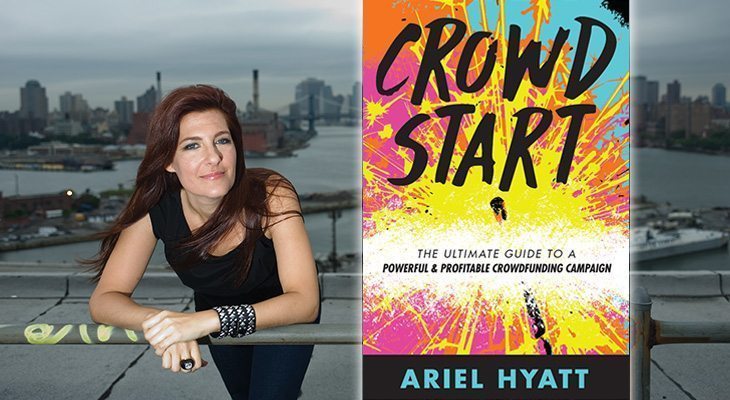Connecting with an engaged online community is key to a successful crowdfunding campaign. But it’s not enough to just gather followers and share your campaign. Once you’ve identified your community, it’s helpful to fine-tune your message by sorting your fans into one of three communities as outlined below. Each of these communities is looking for and inspired by different needs. Crafting your campaign message to each community will ensure you are connecting with your fans in the best way to fulfill their needs and wants while helping you reach your fundraising goals.
The following excerpt was reprinted and selected exclusively for StartupNation readers from “Crowdstart: The Ultimate Guide to a Powerful and Profitable Crowdfunding Campaign” by Ariel Hyatt. Copyright © 2016. By permission of Hunter Cat Press. Available wherever books are sold on Oct. 26, 2016.
Your three communities
With mind-numbing numbers in the billions it can feel overwhelming to come up with an effective online strategy that addresses everyone. Here’s the good news: you actually don’t need to worry about the billions — you only need to engage in the hundreds to have a fully successful crowdfunding campaign. Here is a way to frame it that I call Your Three Communities.
While your fans may have a great deal in common with you, they differ in their level of engagement with you. In fact, your crowd is not just one, lumped-together, group of people. Instead, it is three very separate communities and you have varying degrees of connection with each.
Most people have only one online strategy for connecting with these three totally separate groups. This is a problem, as each group will respond differently to your communication. Yes, there will be overlap between them, but not as much as you may believe. Creating, developing and maintaining your relationships with each community will require a different strategy, and you should put some careful consideration into the strategies you choose for each as you prepare for your crowdfunding campaign.
Related: 5 Things Entrepreneurs Need to Build a Career Plan
Community number one: super fans
These people are your best customers. They buy your offerings (if you have them), follow whatever you do and evangelize strongly on your behalf. Often you know many of them by name. The friends and family who support you are part of this group. They will most likely be the first engaged community you had when you started building. It is this community from which you will pull your VIPs during your crowdfunding campaign. You will read more about that as we move into your campaign.
Because Super Fans are so supportive of your efforts, it is easy to overlook them in your quest to build new numbers. This neglect can come back to bite you when you start crowdfunding. Did you ever see a teenager who completely ignored his or her grandparents, or aunts and uncles, only to start being reeeeeeallly nice to them right before the holidays or graduation so the relatives will hand out better gifts or checks? If you were the teen’s aunt or uncle, how would that make you feel? Kind of used, right? Well, it’s pretty much the same with your Super Fans. If you haven’t made a concerted effort to communicate with your Super Fans consistently, you run the risk of sacrificing their support. I think you should engage your Super Fans in as many ways as possible, to keep the relationships strong and to let them know how much you value them.
The way you engage with your Super Fans is with personal connection. They probably already have your email or phone number, and you have theirs, so contact them on a regular basis to share what you’re up to and ask how they’re doing. Having said that, don’t neglect the other ways to keep your Super Fans informed on your creative and entrepreneurial life. Ask them if you can sign them up to receive your newsletter. Reach out to them on Facebook, both personally and on your Page. Ask them to follow you on Twitter and LinkedIn, and you should follow them as well. I will thoroughly go through how to use your socials to engage your Super Fans later in the book.
Community number two: engaged fans
This is your active online audience. They may already be newsletter subscribers, blog readers and social media friends who read, watch, and comment.
This community engages with you through the content you post online. They pay attention to status updates, tweets and blog post that either (1) gives them great information they couldn’t get otherwise, or (2) shares something personal.
More importantly, Engaged Fans respond when you engage with them. So when they post comments on your website or socials, take the time to reply and start a real dialogue. Most importantly take the time to shine the light on them by sharing what they are doing on your socials and thoughtfully adding to their conversations and ideas.
TIP: On all socials, you must follow the people who follow you. This says, “I am equally as interested in you as you are in me,” and is a cornerstone to creating greater engagement with your fans. Don’t be the jerk who expects a big following without following back.
Community number three: ambient fans
This is your passive online audience that is aware of you but doesn’t actively communicate with you. These people may be your Facebook “friends” (or friends of friends), second or third-level connections on LinkedIn, subscribers to your mobile text alerts or Twitter feed — but they’re not really engaged with you or your endeavors. Sure, they may see your name and status updates every now and then, but the information is just part of what New York Times tech writer Clive Thompson calls their “ambient awareness” of the digital universe.
Strangely enough, the small status updates, tweets, posts, etc. are important, because they make you seem more “real” to your Ambient Fans and make them receptive to your products, services, or crowd-funding campaign. “Each little update — each individual bit of social information — is insignificant on its own, even supremely mundane,” writes Thompson. “But taken together, over time, the little snippets coalesce into a surprisingly sophisticated portrait of your friends’ and family members’ lives…” — and of yours.
The key to converting Ambient Fans into Engaged Fans is sharing relevant information, mixed in with personal touches, through your social media channels. I once discussed this with a friend of mine who was complaining about people who tweet endlessly about things like, “I’m drinking coffee.” When I reminded her that I tweet about coffee a lot, she replied, “Yes, but you also tweet interesting articles and blog posts about our industry, updates on cool places to eat, shop, and visit. I get to pretend I’m with you having that coffee when you travel,” she answered. It turned out the coffee tweets from me didn’t bother her at all when they were part of a larger conversation that feels relevant to her.
What constitutes “relevant information”? Go back to our crowd ID exercise — the simple answer is that if it is relevant to you, it’s probably relevant to all three of your communities.
Sign Up: Receive the StartupNation newsletter!
Communicating with your communities
When getting ready to crowdfund, it’s important to understand the distinct difference between (1) a Super Fan that you know is willing to part with money to support you, (2) an engaged fan who, with some effort, can become a Super Fan and a crowdfunding contributor, and (3) an Ambient Fan that may just be seeing your posts on socials. The idea here is to consider all of your fans and take a good assessment of how many there are, as well as their current level of engagement with you. Then you can focus on both growing your crowd and deepening your relationships with all three communities.
“Crowdstart: The Ultimate Guide to a Powerful and Profitable Crowdfunding Campaign” is available now.






